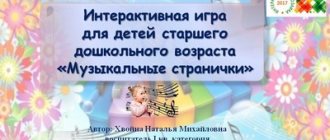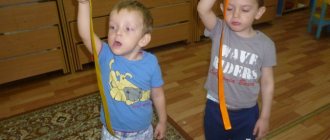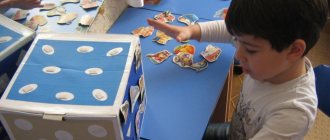Game "Who does what"
This game enriches children's vocabulary with words-actions (verbs) and allows not only to activate monologue speech, but also the expressiveness of non-verbal means of influencing listeners. Within this option, there are several ways to organize the game action.
b) With older preschoolers, the game can be played without a visual basis. An adult names an object, a phenomenon, an object, and the players take turns calling the action performed by this object and a noun word for the next player. For example, the presenter says: “Car.” The child answers: “He’s going.” Artist". Next player: “Draws. Hand”, etc. Later, several verbs are invented for one noun word. For example, “wind” howls, raises dust, tears off leaves, inflates a sail, turns the wings of a windmill, refreshes, disperses clouds, etc.
c) The game can be complicated through the use of non-verbal means of expression: gestures, facial expressions, pantomimes. The children's task is to name the activity based on one or more actions. For example, an adult raises both hands - this action can mean lifting an object, hanging laundry on a line, etc.; or raises his hand, places one finger on the lower right corner of an imaginary page, turning it over - this can mean either reading a book, or looking at a notebook or magazine.
d) A more complex version of the game involves combining verbal descriptions and non-verbal means of expression. To organize play action, soft toys are needed - a cat and a dog. After the children have gotten to know them - examined them, played with them - offer to describe their appearance, habits, place of residence, and show what the cat does when it is stroked. When does she see the mouse? When he sees a thread with a bow? When does he see a dog? What else can a cat do? What can a dog do? How does she behave when she sees a cat? The owner? When does he receive a piece of meat?
Be sure to praise the child if he found a good word, movement, pose, gesture, and showed activity and interest in finding expressive means. This is how children develop observation, accuracy of perception and mental activity (memory, imagination). Next time you can use other objects, but they should be familiar to the child. The nature of the proposed tasks and questions can be expanded, and subsequently invented by the children themselves.
Source
The purpose of the didactic game “Professions”
The goal of the game is to expand and consolidate ideas about all kinds of professions, their characteristics and importance for society, the working tools used, and the products produced.
Game objectives:
- remembering the names of professions;
- expanding knowledge about the tools and devices needed to perform professional duties;
- clarification of the purpose and characteristics of professions;
- clarifying the idea of where people work, what clothes they wear, what actions they perform, and what their workplace looks like;
- developing an idea of what employees should know and be able to do;
- fostering a respectful and grateful attitude towards the work of others;
- developing an understanding that every profession is important, and the results of work are of great importance;
- instilling the desire to work hard and become a good worker;
- development of speech skills, the ability to think logically and perceive information by ear.
Summary of educational activities for speech development “Who does what?” (early age group)
Natalya Mareich
Abstract of the NOD on speech development “Who does what?” (early age group)
Notes on speech development.
Topic: "Who does ?"
Teach children to look at pictures and understand their content.
Activate the vocabulary of familiar words, enrich the vocabulary with words denoting actions. Develop perception , attention, and the ability to answer a question in a short sentence. Cultivate interest in people around you and looking at pictures.
Consider subject and plot pictures in the morning hours individually and with subgroups of children . Prepare a set of pictures, one for each child in the subgroup . Bunny hat.
Didactic games “Professions” in the senior group
Preschoolers in the older group should already know a wide range of professions, as well as have an idea of the professional responsibilities of different workers and the tools they use.
List professions starting with the selected letter
The teacher places cards with letters face down on the table. Children take turns coming to the table, taking a card, calling professions that begin with the chosen letter:
- A – actor, agronomist, astrologer, administrator, aviator, lawyer, architect, obstetrician;
- B – accountant, bookseller, bartender, banker, accordion player, librarian, ballerina, boxer;
- B – doctor, makeup artist, driver, diver, teacher, veterinarian;
- G – geologist, governess, loader, make-up artist;
- D – janitor, conductor, designer, nutritionist, truck driver, milkmaid, dispatcher, director;
- F – livestock breeder, journalist, jockey;
- Z – sound engineer, zoologist, manager;
- I – inspector, engineer, inventor, art critic, illustrator, historian;
- K - astronaut, clown, captain, combine operator, composer, cashier, fireman, blacksmith;
- L – laboratory assistant, pilot, lumberjack, speech therapist;
- M – driver, fashion model, painter, nurse, meteorologist, mechanic, installer, musician;
- N – nanny, notary, oil worker;
- O – ophthalmologist, waiter, operator, landscaper, security guard;
- P – shepherd, cook, pediatrician, writer, hairdresser, pianist, carpenter, postman, salesman;
- R – director, radio operator, fisherman, reporter;
- S – secretary, plumber, gardener, violinist, mechanic, sculptor, dentist;
- T – tractor driver, turner, chimney sweep, trainer;
- U – cleaner, teacher, scientist;
- F – photographer, florist, pharmacist, farmer, philosopher, football player;
- X – surgeon, artist, choreographer;
- Sh – miner, seamstress, driver, plasterer;
- E – ecologist, electrician, tour guide, economist, excavator operator;
- Yu is a lawyer, cabin boy, jeweler.
What is this builder called?
The game introduces preschoolers to construction professions. The teacher says what the person does, and the children answer what they call him:
- paints walls - painter;
- covers the roof with tiles - a roofer;
- builds a house from brick - mason;
- connects metal parts - a welder;
- lays tiles on the walls - a tiler;
- makes the walls smooth, applies plaster - plasterer;
- makes parts from wood - carpenter.
Name your profession based on the result of your work
The teacher shows the pupils cards depicting the result of the work, and they must guess who is doing the work. For example, the picture “suit” is the profession “seamstress”. Or “cake” – “confectioner”. Or “house” – “builder”.
Name the extra item
The teacher places in front of the children 4 illustrations of tools used by certain workers. One of the items is superfluous, it must be pointed out with an explanation of the reason for the choice. For example, “trowel”, “helmet”, “drill”, “syringe” - the first three are used by a builder, the last item is used by a nurse.
Ambulance
The game forms in preschoolers an idea of the importance of the medical profession. For the lesson, you need to prepare pictures depicting the tools and consumables that emergency personnel use: a syringe, bandage, iodine, thermometer, bandage, etc.
During the game, different situations are considered. One child plays a doctor, the second plays a patient. The second one tells what problem he has: a broken knee, a scratched hand, bleeding from the nose, sore throat, headache, etc. The child playing the doctor tells what tools and medicines he will use in each specific case. If necessary, the teacher prompts him.
Pharmacy
A role-playing game introduces preschoolers to the profession of a pharmacist. For the lesson you need to prepare pictures depicting medicines and cards imitating “money”. Children distribute roles. One becomes a pharmacist at the cash register, the rest become customers. The roles alternately change.
Customers take turns “entering the pharmacy.” They say that they are worried about whether the medicine they need is available. The pharmacist offers the buyer a product and collects payment. The teacher helps the players, gives tips on prescribing medications, and asks leading questions.
Didactic games “Professions” in the middle group
The task of a teacher in the middle group is to expand and consolidate students’ knowledge about different professions, develop their thinking ability, concentration, ability to navigate, and give clear and competent answers.
What to whom?
To get acquainted with professions, the presenter names the worker, and the children must list the tools, devices and materials that he uses:
- doctor - syringe, stethoscope, medical gown, rubber gloves, bandage, medical card;
- builder - drill, hammer, bricks, boards, helmet, concrete, nails, saw;
- teacher - pointer, class magazine, textbooks, wall maps, blackboard;
- artist - paints, brushes, canvas, palette, easel, paper, pencils;
- cook - dishes, oven, blender, cap, apron, food, recipe book;
- hairdresser - hair dryer, combs, scissors, curling iron, hair dyes, hairpins, mirror;
- gardener - rake, gloves, shovel, seedlings, lawn mower, pruning shears, watering can;
- seamstress - sewing machine, iron, ironing board, scissors, fabric, needles, threads.
This is true?
For the game you need to prepare pictures depicting people of different professions in appropriate attire. Each player receives two cards: red – the answer is “no”, green – “yes”.
The presenter shows the children a picture and says who the person drawn works for. Players must understand whether what is said is true and raise the appropriate card. For example, the presenter, showing a picture of a fireman, says: “This is a teacher.” Children hold up a red card.
Work clothes
To play, you need to cut out paper images of a girl and a guy, as well as different work clothes.
The teacher says that the paper characters are going to go to work, but they need help choosing the right suit. The game can be built in different ways. The teacher names a profession, and the children choose the correct one from a heap of paper clothes. Or the teacher chooses the costume himself, and the players name the character’s place of work. When the children have sorted out their work wardrobe, the teacher asks them to close their eyes to consolidate the acquired knowledge, and he himself rearranges the clothes and asks them to find the mistake.
Work transport
To play, you need to arrange chairs and attach to each chair an image of a specific car: ambulance, fire, police, bus, plane, train and others. And cut out “steering wheels” from cardboard with professions written on them.
The presenter gives each player a steering wheel and names their profession. The player must find his “car”, sit on a chair, steer, “going to work”. The game is repeated, the presenter changes the players' steering wheels.
For a cook or a doctor?
This didactic game “Professions” for kindergarten systematizes ideas about the work responsibilities and professional characteristics of a cook and a doctor.
Two children are playing: one is a cook, the other is a doctor. The presenter pulls items out of the bag and asks which worker needs them. For example, a doctor needs a syringe, a cook needs a spoon. Children should not just answer, but explain why the employee needs this item.
Progress of educational activities.
Surprise moment. A plaintive meow is heard behind the door.
Who meowed at the door?
Open quickly!
It's very cold in winter.
Murka asks to go home.
(the teacher lets the cat into the group and speaks on behalf of the cat).
Hello children. (children greet the cat)
. Guys, it's very cold outside, I'm frozen, warm me up.
Educator. How can we warm you up? I have a scarf. (Takes a scarf and ties it around her neck)
.Children, what am I
doing ?
Children. Tie a scarf for the cat.
Cat. Thank you very much I feel very warm. Guys, I didn’t come to you empty-handed. I brought beautiful pictures, let's see together what they show.
(The teacher shows a picture of a boy playing a drum ).
Educator. Who do you see in the picture? What is he doing ? What does he play ?
Children. A boy plays the drum . Knocks on the drum with drumsticks. The drum sounds boom - boom - boom; bam - bam - bam.
(the teacher invites the child to reproduce the action depicted in the picture.
(The teacher shows a picture of a dog sawing a log)
.
Educator. Who do you see in the picture? What is he doing ? Children's saw makes this sound "whack - whack"
.
Children. This is a dog. The dog is sawing a log. He is sawing with a saw. The saw is sharp.
(the teacher invites the child to find the desired object on the table and reproduce the actions depicted in the picture).
(The teacher shows a picture of dad working with a hammer).
Educator. Who do you see in this picture? Who is this? What is he doing ? How does a hammer sound?
Children. This is Dad. He works. He knocks with a hammer. The hammer knocks “knock-knock-knock”
.
The teacher invites the child to the table and asks him to find a hammer. Asks the child to reproduce the action shown in the picture.
“The teacher shows a picture of a steam locomotive).
Educator. Children what is this? How does it hum, how do the wheels knock?
Children. This is a steam locomotive. He hums "doo-doo-doo"
.
The wheels are knocking “chug-chug-chug”
.
“The teacher offers the children a ride on a steam locomotive and reads a poem”
He brought the trailers.
Chug - chug - chug I'll rock you far. (Children sing along with the teacher)
.
Educator. Guys, you liked looking at the pictures.
(The teacher offers to feed the cat milk. Children make a “bowl”
joining your palms. The teacher sings a song).
The pussy suited the children
Children, who came to visit us today? What did the cat bring you? Did you like the pictures? What did you give the cat?
Didactic games Didactic game “Multi-colored rugs” Purpose: to develop visual perception of the sense of color; memory, attentiveness, tactile sensations.
Source
Didactic games “Professions” in the younger group
Preschoolers of the younger group learn through games how important all professions are and what different workers do.
Salon
Pupils do the dolls' hairstyles and take care of their hair using various devices and products. The teacher observes the work of the pupils, coordinates them, and suggests rules for caring for their appearance. It is important to draw children’s attention to how ugly dolls look while they are unkempt and unkempt, which means that the profession of a hairdresser is necessary. You should also tell children about the tools used in the hairdressing salon and their purpose.
Guess the profession based on the subject
The teacher pulls an item out of the bag, and the children say who might need it. For example, a cook needs a ladle, a nurse needs a bandage, a painter needs a brush, and a hair dryer needs a hair dryer.
Guess who am I?
Children stand in a circle. Each player, in turn, goes to the center and begins to depict a certain action, without saying a word, using only facial expressions, body movements, and inarticulate sounds. The rest must guess who the comrade is portraying. For example, a child makes twisting movements with his hands, imitating a steering wheel, and says “w-w-w.” This is the driver.
Correct mistakes
The presenter names paired phrases, and the children say what the mistake is and how to say it correctly:
- the teacher mows the lawn and the gardener writes on the blackboard;
- a barber puts out a fire, and a fireman does a haircut;
- a musician paints the walls and a painter plays the piano;
- the nurse prepares a pie, and the cook gives an injection to the patient;
- the builder offers books to readers, and the librarian builds brick walls.
Didactic games “Professions” in the preparatory group
Older preschoolers are preparing for school, so games are important for them to develop speech and improve their skills in correctly forming sentences.
Divide the word
The presenter names a profession formed from two words. Children try to break it into pieces to find out the meaning. For example, “chimney sweep - pipes and clean”, “fisherman - fish and catch.”
Choose a word for your profession
The player’s task is to choose a suitable epithet for the profession. For example, “the teacher is kind,” “the ballerina is slender,” “the nurse is caring.”
Continue the sentence
The teacher begins a sentence concerning the professional responsibilities of various workers, and the students complete it by listing the objects of action. Eg:
- the gardener waters... the lawn, flower bed, bushes, trees, beds;
- the cook cuts with a knife... meat, vegetables, fish, fruits, bread;
- the driver carries passengers by... taxi, bus, tram, trolleybus.
Didactic game for children of primary preschool age “Who is doing what?”
Anastasia Samsonova
Didactic game for children of primary preschool age “Who is doing what?”
Program content of the game: promote the development of children's as a means of communication; promote the development of understanding of adult speech; enriching children's vocabulary with verbs denoting actions; contribute to the formation of the ability to coordinate nouns with verbs, answer the questions “Who?”
,
"What?"
,
"What
is he doing ?" ;
developing children’s to clearly pronounce words and phrases.
Contents of the game: children 1.5-3 years old are shown one of the cards and asked a series of questions: “Who is drawn in the picture?”
,
"What is he
doing ?" .
If a child has difficulty answering a question, an adult helps with leading questions and phrases. Further, the content of the game can be complicated by asking the child more questions that reveal the content of the card. For example, “What color is the hen’s scarf/squirrel’s sundress?”
,
“What do you think the raccoon is watching on TV?”
,
“Why does a monkey brush its teeth?
Do you brush your teeth?” etc., encouraging the child to use various words and phrases in speech.
“Didactic game as a form of teaching children of primary preschool age” Municipal budgetary preschool institution kindergarten No. 11 “Umka”, Pavlovo Consultation for teachers on the topic: “Didactic.
Didactic game “Pick a button for the snowman” for children of primary preschool age “Pick a button for the snowman” Didactic game for children of primary preschool age Developed by the teacher of the State Budgetary Educational Institution Dolgushina N. A. Po. Didactic game “Whose things are these?” for children of primary preschool age Didactic game “Whose things are these?” is aimed at developing gender education for children of primary preschool age. Purpose: to teach children. Didactic game for children of primary preschool age “Collect a picture” Didactic game for children of primary preschool age “Collect a picture” (cycle “Do it yourself for children”) Materials: household. Didactic game for children of primary preschool age “Lay out from sticks” The game “Lay out from sticks” is very interesting and attractive for children of primary and middle age. The player's task is to lay out.
Didactic game “Apples-Flowers” for children of primary preschool age Expert map of electronic educational resource (EER) Author, position Title Age category Tasks Contents Opportunities.
Didactic game as a means of sensory education for children of primary preschool age Sensory development is the foundation of the general mental development of the child, which, in turn, is an essential condition.
Didactic game “Dress up a matryoshka” for children of primary and secondary preschool age Author: Aubakirova Dinara Idayatovna Position: Educator. Goal: consolidate knowledge about geometric shapes. Objectives: teach grouping.
Didactic game “Collect a caterpillar” for children of primary preschool age Dear colleagues, I bring to your attention another didactic game. I got the idea for the guide from the Internet, but it took me a while to figure it out. Didactic game “Funny Little Bears” for children of primary preschool age Knowledge of sensory standards begins from an early age. This is the perception of phenomena and objects surrounding the child. He cognizes, compares, selects. I.
Source




